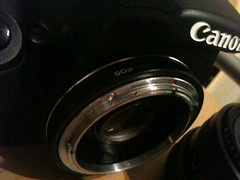I'm having a crisis of sorts. Finally after some significant time and heartache I have the camera gear that I have been aiming for for some time. I've practised and somewhat mastered, or at least got the hang of, various aspects of photography, from portraits to close ups, from shallow depth of field to live music. But there was something ... missing. And I finally figured out what it is; I like manual focussing.
Way back in the mists of time, or last October to be more precise, I finally got round to digging out my lovely old Zenit E and took some lovely Autumnal pictures. The Helios 58mm f/2 prime lens made me realise how good a decent prime can be, after years of struggling with slow kit lenses or crappy compacts. It has ended up being very much my standard "out and about" configuration, albeit with some slight modifications.
Moving on a little, I got my hands on the Nikon 50mm f/1.8 prime and took some more Autumn pictures. I raved about it, that moment of realisation of what I was missing out on by sticking to a relatively slow and clunky kit zoom.
Since then, and after a rather harrowing week of losing the lot to a break in, I have moved on with my kit to try and cover all bases. And the more I have got, the less I have tended to use the kit zoom. In fact, saving a few occasions when I've really needed an 18mm lens, it's not been on my camera at all. Even the shiny shiny EF 28-135mm IS USM is underused. It's just not fast enough, and it weighs almost half a kilo.
I've still got the two of those lenses, because they do come in handy at times. They have their uses. But for a good while now my "go to" lens has been the (in)famous Nifty Fifty; the Canon EF 50mm f/1.8. A clunky plastic little number with not even so much as a distance scale. But it takes some amazing pictures.
So what on earth could I ask for to make it better? Well, the one thing the Helios has they my current crop of lenses don't; decent manual focus. The 50mm feels light and imprecise. The 28-135mm has the best of the lot, due to the USM autofocus and full time manual, but it still doesn't have the satisfying heft of a full manual lens, nor does it take much of a turn to go from one end of the focal range to the other. Focussing precisely is not an easy task because even a small rotation can throw the focus off completely.
The reasons for this are plain and perfectly acceptable. In order to get good autofocus performance, the focus ring needs to be light and free-turning. It needs to have a short range of travel and it needs to have the ability to disengage from the motor. But all this means that, while autofocus works brilliantly, focussing manually does not.
"So what?" I hear you exclaim. "Surely getting the camera to focus for you is easier?" Well, yes and no. It's very convenient, that's for certain. But it also brings a raft of other issues. Do you let the camera decide what to focus on, or do you manually tell it using the multi-point autofocus system? Do you faff about setting it to always use the exact focus point, or go for the focus-lock-and-recompose method?
Honestly, playing with the Zenit with its lovely, hefty Helios manual focus lens made me realise how much a manual focus can bring you closer to your subject. Setting the focus exactly where it needs to be and having that control be as easy and comfortable as possible makes a vast difference to the feel of taking the photograph. That feeling can translate directly into the final image.
Now, my dad recently got himself a Pentax Kx. It's a cool camera and, thanks to Pentax's insistance of evolution over revolution, works with all the newest Pentax lenses as well as any of the older lenses from years gone by. As a Canon EOS user, I don't have that luxury. I can use EF (or EF-S) lenses ... and that's it. Which puts the price of a 28mm f/2.8 at around £150. Ouch.
Thankfully, eBay came to the rescue. For a fairly reasonable sum of £26 I picked up an EOS-to-FD convertor to allow me to use any old FD mount lens I laid my grubby mits on. It's quite a nice thing, actually; solidly built, with metal lens mounts at either side, and a locking ring for the FD lens itself. It even has a tiny glass corrective lens in it to ensure the distance from the sensor doesn't cause issue, as can often happen when an adapter ring is put between the body and the lens. A few mm here and there can make all the difference, and render a good lens useless. In the case of FD lenses mounted on EOS bodies, without the corrective optics the lens loses the ability to focus beyond about 3 metres.
Now I had a way to put an old manual focus lens on my camera, what lens to get? Well, eBay came to the rescue once again and provided me with a Makinon 28mm f/2.8 for a mere £10. Makinon used to make lenses for all sorts of cameras, usually with the option of automatic aperture control, but always with manual focus. They are not well regarded, by all accounts, but for a tenner it seemed worthwhile. After all, with the adapter ring on the body already, I could always upgrade to proper Canon FD lenses should I happen across any in second hand stores or on eBay.
So does it work? Well, yes. Yes it does. It's full manual, meaning that I have to use the aperture ring to set the aperture and use stop-down metering.This means I have to open up to focus then close the aperture to take the picture, or hope that I can see well enough through the closed lens to focus properly. There is no quick preview switch to open the aperture for focussing, sadly. Update: I'm talking rubbish. The adapter ring actually has a little pin that manipulates the preview. Rotate one way, it opens the aperture; rotate the other and it stops down to whatever the lens is set to. I still have to use stop-down metering but at least I can see to focus. It does seems to overexpose by about 1 stop when closed down below wide open. The highest aperture is a pretty feeble f/16. By any modern standard, it's a pretty rubbish lens. But it cost a tenner.
But then I try the focus ring. Like a breath of fresh air, it turns so smoothly, yet doesn't ever feel loose or imprecise. When I stop turning it, it stops turning. Knocking it gently with my thumb won't throw it off. It takes a full 180 degrees of turning to go from one extreme (about 6 inches) to the other at infinity. It is, in short, just what the doctor ordered. It's not particularly slow either. In fact, in low light I can focus faster with this than when trying to convince the nifty fifty that it really does want to focus ... honest ...
But the question is, I suppose, how does it perform? Am I just talking rubbish and am actually really terrible at getting pictures in focus? Here is a small selection of pictures that I think demonstrate what I can do with it. They're not all amazing, but they give an idea.
Way back in the mists of time, or last October to be more precise, I finally got round to digging out my lovely old Zenit E and took some lovely Autumnal pictures. The Helios 58mm f/2 prime lens made me realise how good a decent prime can be, after years of struggling with slow kit lenses or crappy compacts. It has ended up being very much my standard "out and about" configuration, albeit with some slight modifications.
Moving on a little, I got my hands on the Nikon 50mm f/1.8 prime and took some more Autumn pictures. I raved about it, that moment of realisation of what I was missing out on by sticking to a relatively slow and clunky kit zoom.
Since then, and after a rather harrowing week of losing the lot to a break in, I have moved on with my kit to try and cover all bases. And the more I have got, the less I have tended to use the kit zoom. In fact, saving a few occasions when I've really needed an 18mm lens, it's not been on my camera at all. Even the shiny shiny EF 28-135mm IS USM is underused. It's just not fast enough, and it weighs almost half a kilo.
I've still got the two of those lenses, because they do come in handy at times. They have their uses. But for a good while now my "go to" lens has been the (in)famous Nifty Fifty; the Canon EF 50mm f/1.8. A clunky plastic little number with not even so much as a distance scale. But it takes some amazing pictures.
So what on earth could I ask for to make it better? Well, the one thing the Helios has they my current crop of lenses don't; decent manual focus. The 50mm feels light and imprecise. The 28-135mm has the best of the lot, due to the USM autofocus and full time manual, but it still doesn't have the satisfying heft of a full manual lens, nor does it take much of a turn to go from one end of the focal range to the other. Focussing precisely is not an easy task because even a small rotation can throw the focus off completely.
The reasons for this are plain and perfectly acceptable. In order to get good autofocus performance, the focus ring needs to be light and free-turning. It needs to have a short range of travel and it needs to have the ability to disengage from the motor. But all this means that, while autofocus works brilliantly, focussing manually does not.
"So what?" I hear you exclaim. "Surely getting the camera to focus for you is easier?" Well, yes and no. It's very convenient, that's for certain. But it also brings a raft of other issues. Do you let the camera decide what to focus on, or do you manually tell it using the multi-point autofocus system? Do you faff about setting it to always use the exact focus point, or go for the focus-lock-and-recompose method?
Honestly, playing with the Zenit with its lovely, hefty Helios manual focus lens made me realise how much a manual focus can bring you closer to your subject. Setting the focus exactly where it needs to be and having that control be as easy and comfortable as possible makes a vast difference to the feel of taking the photograph. That feeling can translate directly into the final image.
Now, my dad recently got himself a Pentax Kx. It's a cool camera and, thanks to Pentax's insistance of evolution over revolution, works with all the newest Pentax lenses as well as any of the older lenses from years gone by. As a Canon EOS user, I don't have that luxury. I can use EF (or EF-S) lenses ... and that's it. Which puts the price of a 28mm f/2.8 at around £150. Ouch.
Thankfully, eBay came to the rescue. For a fairly reasonable sum of £26 I picked up an EOS-to-FD convertor to allow me to use any old FD mount lens I laid my grubby mits on. It's quite a nice thing, actually; solidly built, with metal lens mounts at either side, and a locking ring for the FD lens itself. It even has a tiny glass corrective lens in it to ensure the distance from the sensor doesn't cause issue, as can often happen when an adapter ring is put between the body and the lens. A few mm here and there can make all the difference, and render a good lens useless. In the case of FD lenses mounted on EOS bodies, without the corrective optics the lens loses the ability to focus beyond about 3 metres.
Now I had a way to put an old manual focus lens on my camera, what lens to get? Well, eBay came to the rescue once again and provided me with a Makinon 28mm f/2.8 for a mere £10. Makinon used to make lenses for all sorts of cameras, usually with the option of automatic aperture control, but always with manual focus. They are not well regarded, by all accounts, but for a tenner it seemed worthwhile. After all, with the adapter ring on the body already, I could always upgrade to proper Canon FD lenses should I happen across any in second hand stores or on eBay.
So does it work? Well, yes. Yes it does. It's full manual, meaning that I have to use the aperture ring to set the aperture and use stop-down metering.
But then I try the focus ring. Like a breath of fresh air, it turns so smoothly, yet doesn't ever feel loose or imprecise. When I stop turning it, it stops turning. Knocking it gently with my thumb won't throw it off. It takes a full 180 degrees of turning to go from one extreme (about 6 inches) to the other at infinity. It is, in short, just what the doctor ordered. It's not particularly slow either. In fact, in low light I can focus faster with this than when trying to convince the nifty fifty that it really does want to focus ... honest ...
But the question is, I suppose, how does it perform? Am I just talking rubbish and am actually really terrible at getting pictures in focus? Here is a small selection of pictures that I think demonstrate what I can do with it. They're not all amazing, but they give an idea.








Comments
Post a Comment